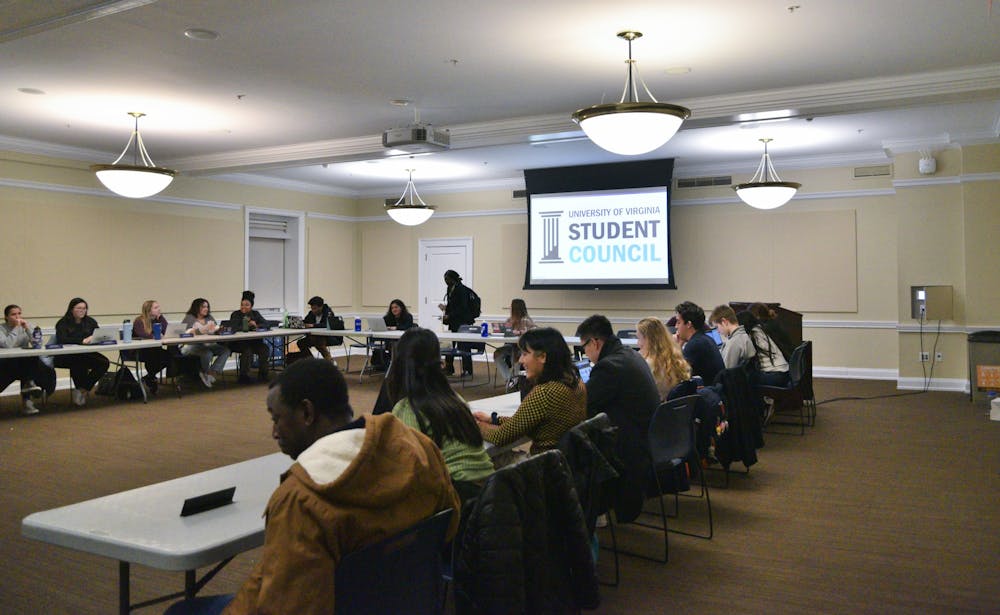This spring, Student Council will operate with a budget of $177,020 — almost five semesters of tuition and fees for an in-state student — and will focus on student-centered support such as free Sexually Transmitted Infection testing and providing Cavalier Advantage Grants. This spring’s budget is a four percent decrease from last spring’s budget of $184,671, but a nine percent increase from $162,470 in the fall.
$168,485 of the budget comes from the Student Activities Fee — the $50 fee students pay yearly as part of their tuition — and $8,535 comes from private, non-SAF funding. Historically, the non-SAF money comes from the $25 table fee for Contracted Independent Organizations at the Fall Activities Fair. This year saw no substantial flow into this pool following the elimination of the tabling fee.
Ceci Cain, Student Council president and Batten student, said she sees the budget as concrete evidence of the organization’s evolving efforts to benefit the student body.
“[The budget] shows a shift in the amount and type of resources that we have been able to provide as a student government,” Cain said. “More first-generation, more low-income students and students of color are being prioritized through our budget.”
Though the Student Council allocates money in categories ranging from the community food pantry to alumni relations, this semester, two major agencies are receiving significant increases in funding — the Safety and Wellness Agency and the Financial Accessibility Agency, both of which directly service students in need of financially accessible resources and support.
This semester, the Safety and Wellness Agency will receive $16,000 of SAF funding, a dramatic increase from the $1,675 allotted last spring. $15,000 will cover transportation to and testing at STI clinics.
This fund will continue the free STI screening program that Student Council initiated Jan. 18 but had to pause less than two weeks later following high student demand. According to Cain, over 200 students had already been screened — with the increased budget allotment, students can continue to access free screening through Student Health and Wellness.
“This semester, STI testing is probably the thing that I am most excited about,” Cain said. “I'm excited to see where these projects will be in a couple of years and ideally with this program, STI testing will be free for everyone through Student Health at all times.”
Some of the remaining portion of the money will be used to provide free menstrual products in all female-identifying hall restrooms and all male-identifying restrooms on the first floor of five dorm buildings.
The Financial Accessibility Agency will receive $8,000 in SAF funding, in contrast to the $3,500 given last spring. This funding will go towards Cavalier Advantage Grants, a program designed to support students by way of grants to be used for printing, laundry and personal care items. Students can apply for up to five $5 grants throughout each semester.
Allocation and utilization of the budget have historically presented two separate challenges for Student Council — increases in agency budgets are only effective when the money is actually used.
Lillian Rojas, chair of the representative body and third-year Batten student, said that advertising efforts are instrumental in increasing awareness of the programs available and increasing utilization rates.
“It's hard to get the whole student body to engage,” Rojas said. “I feel like if the whole student body actually knew exactly what we were doing, there would be no problems with having the money being used.”
Last fall, 52 percent of the budget was utilized, an increase from historical levels ranging from 15 to 30 percent. Jaden Evans, vice president for administration and fourth-year College student, said that while this number may appear low, it is much higher than in previous years. According to Evans, between 2017 and 2020 utilization fell somewhere between 15 and 30 percent.
“It sort of indicates a really high level of engagement with the resources we're offering,” Evans said.
Most initiatives, Evans said, either use almost all of their funding or close to none, which may indicate a given program’s progress as opposed to issues with advertising.
“[The utilization is] more a matter of which initiatives were successfully launched and kind of got off the ground, and which just never happened at all,” Evans said.
Rojas said she hopes that more students will take advantage of the widely-available Student Council initiatives like Cavalier Advantage Grants this semester, especially given complaints over having to pay for laundry within dorms.
“For your essentials and your day to day life as a University student, you need to print, you need clean laundry,” Rojas said. “We want to have more students know about it because we have the money so they can be helped. We just need to find a way for them to know that.”
Student dollars will also go towards providing funds for a total of 23 agencies and initiatives including the President Cabinet Agency, Diversity Engagement Agency and the Student Life Agency.
The PCA has a budget of $100,100 — an increase of $37,465 from last spring’s budget. The PCA is responsible for the administration and carrying out of the president’s short and long-term goals, which include diversity grants and more support for historically underserved CIOs.
Additionally, The DEA will receive $31,500 in SAF funding and $500 in non-SAF funding, which will be directed toward diversity grants. This figure represents an increase from the $26,075 given last spring.
The Student Life Agency will receive $3,500 in SAF funding designated to the creation of roughly 100 nonperishable meal kits for students who experience food insecurity during Spring Break.
The full spring budget can be found here.







